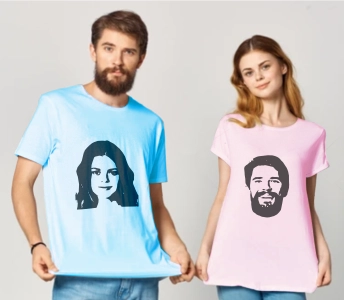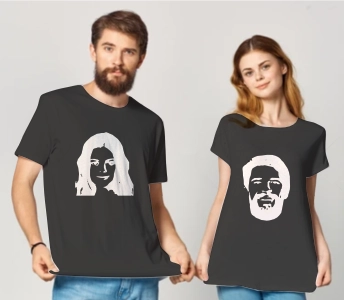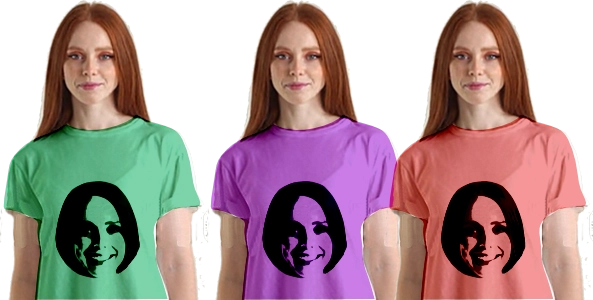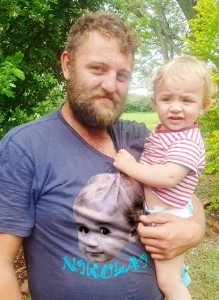Custom T-Shirt or other garment printing.
What would you call it? Fabric, garment or material printing. It's all about the same thing, printing on material.
We specialise in two types of fabric printing, namely DTF (Direct to Film) Printing and HTV (Heat Transfer Vinyl) for small quantities.
Having your own custom t-shirts printed is a cost effective and brilliant way to advertise your business, school, charity events you are planning or even just a slogan.
Just about any event can be improved by custom printed t-shirts and any individual or group will be able to benefit from it. Print customised T-shirts for your:
- Associations
- Baby showers
- Bachelor parties
- Businesses
- Class reunions
- Commemorative events
- Company anniversaries
- Corporate events
- Family events
- Fund raisers
- Practical giveaways
- School events
- Sponsored events
- Sports teams
- Tours and travel
- University events


DTF (Direct-to-Film) printing.
DTF printing, which stands for Direct-to-Film printing, has some great benefits compared to other methods like screen printing or heat transfer.
One of the biggest advantages is that DTF printing creates prints that are very detailed and colorful. These prints are also tough, meaning they won’t easily fade, crack, or peel over time, so they last a long time. Another cool thing about DTF printing is that it can be used on many types of fabrics.
You can print on cotton, polyester, and even blends of different materials.
This makes DTF printing a very flexible option for different projects. So, how does DTF printing work? It involves transferring designs onto fabric using a special film, ink, and adhesive powder. After that, a heat press is used to make the print stick to the fabric. Overall, DTF printing is a great choice for anyone looking to create high-quality designs on various fabrics.

Here’s how it works:
- Printing:
A special design is printed on a special film called PET film using special printers and inks that are safe for the environment. - Powder Application:
While the ink is still wet, a special powder that helps stick things together is sprinkled on the film. - Curing:
The film is then heated up. This melts the powder so it sticks to the design. - Transfer:
Finally, the design is moved from the film to the fabric using a heated machine called a heat press.
Advantages of DTF Printing
- Bright and Detailed Prints:
DTF printing makes colorful designs that look great and have lots of details. - Durability:
The prints do not easily fade, crack, or peel. This means they can stay nice for a long time. - Versatility:
DTF printing can work on many types of fabrics, like cotton and polyester. This makes it good for different kinds of clothes. - Efficiency:
DTF printing is faster because it doesn’t require cutting or weeding, which are steps needed in some other printing methods. - Cost-effective:
DTF printing can save money, especially for smaller orders of clothes. - Sustainability:
DTF printing helps reduce waste. It allows printing only what is needed, so there’s no need to keep lots of extra items in stock.
Disadvantages of DTF Printing
- High Initial Investment:
DTF printing needs a lot of money at the beginning to buy special equipment. This includes a DTF printer, hot melt adhesive powder, and a heat press.This big cost can make it hard for small businesses or people who are just starting out. - More Steps Needed:
DTF printing has extra steps compared to some other printing methods. For example, it needs to apply and cure (or dry) adhesive powder, which takes more time and effort. - Special Materials Required:
DTF printing uses special inks, films, and adhesive powders. These materials might not be as easy to find as the supplies used in more common printing methods.


File Formats Needed for DTF Printing
PNG:
The PNG file format is very popular for DTF printing. One of its best features is that
it can have transparent backgrounds.
This is important when you want a design with clear and sharp edges.
For example, if you are printing a logo or a specific shape, a PNG file can help make the edges look neat and defined.
PDF:
PDF files are very flexible because they can contain multiple layers. They keep your design
clear and detailed, which is perfect for DTF printing.
For DTF printing, high-resolution PNG files that are the same size as the transfer you need (or even larger) and vector file formats are the best choices. These formats also support transparency, which is necessary for DTF printing.
Although JPG files are a common image format, they can be risky. Any changes made to the original JPG file can lower the quality of your image!
Prices for DTF and HTV Heat Transfer Printing
The prices for DTF (Direct to Film) printing can change based on the size of the sheet and the supplier you choose.
For example, the printing and pressing of a T Shirt is R90.00, which includes VAT, but you need to provide the shirt yourself.
Here are some examples of T-shirt printing prices:
A4 size (28cm x 21cm): R90.00
Several factors can affect the price of DTF printing:
- Sheet Size:
Bigger sheets usually cost more. - Quantity:
If you order many items, you might get a discount. - Design Complexity:
More detailed designs can cost extra because they use more ink and take longer to make.
Additionally, some suppliers provide custom sheet sizes, giving you options based on what you need. When you think about the total cost of DTF printing, don’t forget to include the price of other materials like ink and film. Also, consider the opportunity for discounts if you are ordering for a larger project.
